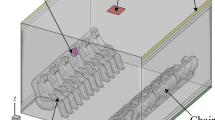Abstract
COVID-19 is transmitted through droplets or aerosols containing the virus, the very small particles exhaled by infected people or exposure to items infected with the virus. These droplets, aerosols and particles may be inhaled by others, or fall into their eyes, mouth and nose. In some cases, they may contaminate the contact surface. It is most likely to be infected if they are less than 1 m away from the infected person. To evaluate the effects of different air conditioning systems on the spread of human exhaled pollutants, computational fluid dynamics (CFD) was used to study the movement and diffusion of exhaled air from two rows of 12 sitting adults in a hospital's closed transfusion room. In this paper, a closed transfusion room with 12 human models was established firstly, and the mathematical model verified by experimental test results was used to study the propagation of viral aerosol particles in the enclosed space under different air conditioning systems. The result showed that when the transverse strong air flow is generated in the room, the concentration distribution of virus particles will show a roll like distribution and the personnel inside the roll will cause new infection. The air flow generated by the air conditioning system will affect the dispersion of droplets in the air. Evaluating and guiding the air flow to avoid blowing air from one person to another may reduce the risk.









Similar content being viewed by others

References
Buccolieri, R., SANTIAGO J-L, RIVAS E, et al. (2019). Reprint of: Review on urban tree modelling in CFD simulations: Aerodynamic, deposition and thermal effects. Urban Forestry & Urban Greening, 37, 56–64.
Cao, W., Sun, B., Zhao, Y., et al. (2021). Study on the transmission route of virus aerosol particles and control technology of air conditioning in the enclosed space. Eur Phys J plus, 136(10), 1049.
Chao, C. Y. H., Wan, M. P., Morawska, L., et al. (2009). Characterization of expiration air jets and droplet size distributions immediately at the mouth opening. Journal of Aerosol Science, 40(2), 122–133.
Ciappi, L., Fiaschi, D., Manfrida, G., et al. (2019). Heat recovery for a textile stenter: CFD analysis of air curtain benefits. Energies, 12(3), 1–22.
Gao, M., Shi, Y. T., Wang, N. N., et al. (2013). Artificial neural network model research on effects of cross-wind to performance parameters of wet cooling tower based on level Froude number. Applied Thermal Engineering, 51(1–2), 1226–1234.
Greenhalgh, T., Jimenez, J. L., Prather, K. A., et al. (2021). Ten scientific reasons in support of airborne transmission of SARS-CoV-2. The Lancet, 397(10285), 1603–1605.
Kang, M., Wei, J., Yuan, J., et al. (2020). Probable evidence of fecal aerosol transmission of SARS-CoV-2 in a high-rise building. Annals of Internal Medicine, 173(12), 974–980.
Li, X., Shang, Y., Yan, Y., et al. (2018). Modelling of evaporation of cough droplets in inhomogeneous humidity fields using the multi-component Eulerian-Lagrangian approach. Building and Environment, 128, 68–76.
Schijven, J., Vermeulen, L. C., Swart, A., et al. (2021). Quantitative microbial risk assessment for airborne transmission of SARS-CoV-2 via breathing, speaking, singing, coughing, and sneezing[J]. Environmental Health Perspectives, 129(4), 047002.
Seto, W. H. (2015). Airborne transmission and precautions: Facts and myths. The Journal of Hospital Infection, 89(4), 225–228.
Wang C. C., Prather, K. A., et al. (2021). Airborne transmission of respiratory viruses. Science, 373(6558), eabd9149.
Xu, C., Nielsen, P. V., Gong, G., et al. (2015). Measuring the exhaled breath of a manikin and human subjects. Indoor Air, 25(2), 188–197.
Xu, C., Nielsen, P. V., Liu, L., et al. (2017). Human exhalation characterization with the aid of Schlieren imaging technique. Building and Environment, 112, 190–199.
Zhao, B., & Wu, J. (2009). Effect of particle spatial distribution on particle deposition in ventilation rooms. Journal of Hazardous Materials, 170(1), 449–456.
Acknowledgements
This study was supported by the National Natural Science Foundation of China (No. 52106104) and the scientific research program of Tianjin Municipal Education Commission (No. 2019KJ109).
Author information
Authors and Affiliations
Contributions
All authors contributed to the study conception and design. Material preparation, data collection and analysis were performed by Xudong Zhang, Wanxiang Yao, Run Sun, Yutong Du, Quanbin Shi, and Zipeng Li. The first draft of the manuscript was written by Weixue Cao and all authors commented on previous versions of the manuscript. All authors read and approved the final manuscript.
Corresponding author
Ethics declarations
Competing interest
The authors have no competing interests to declare that are relevant to the content of this article.
Rights and permissions
Springer Nature or its licensor (e.g. a society or other partner) holds exclusive rights to this article under a publishing agreement with the author(s) or other rightsholder(s); author self-archiving of the accepted manuscript version of this article is solely governed by the terms of such publishing agreement and applicable law.
About this article
Cite this article
Cao, W., Zhang, X., Yao, W. et al. Comparative study on ventilation and air conditioning system schemes based on virus pollution control in hospital infusion room. Aerobiologia 39, 429–439 (2023). https://doi.org/10.1007/s10453-023-09801-x
Received:
Accepted:
Published:
Issue Date:
DOI: https://doi.org/10.1007/s10453-023-09801-x



